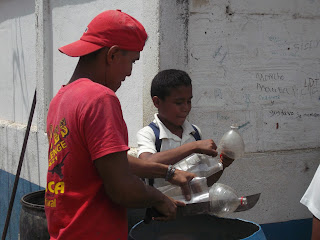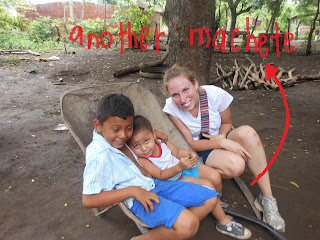A foreigner's guide to the uses of a machete.
Harvesting.
In Nicaragua, there are a variety of savory fruits, some of which are familiar to those sold in the US, some of which are not. However, all types of fruit: Mamones, Tamarindos, Bananas, Mangos, or Plantains can be harvested with a quick swipe from a machete. Other vegetables are often harvested with a machete, especially corn. This swift tool is essential for a successful Nicaraguan harvest.
Pruning.
Every once and awhile we see a couple of men in the local parks using their machetes to cut down the grass and weeds that grow. Machetes are also used for the pruning of public as well as private or personal trees and/or bushes. Keeping Nicaraguan parks and homes looking nice and well-kept is just one use of a machete.
Clearing Large Areas of Land.
During our soccer project, we arrived to find the field overgrown with weeds and sagebrush. But before we had a chance to worry, a local schoolboy used the school machete to clear the field of debris*. In no time, we had a field free of bushes and weeds and we were ready to play. However, clearing a soccer field requires a little bit more technique than maintaining the grass at a local park. When clearing a field, one must swing the machete around the head and then down to whack away the brush, then the arm crosses over the face to bring the machete around the head again. This may seem complicated, but once you watch a native Nicaraguan, you will realize that it really looks quite easy and elementary. Elementary to the point, in fact, that even elementary children help out with these activities. An even larger scale of clearing large areas of land using a machete is the example of clearing ground on which to build a classroom. The particular land that we cleared this morning, for example, was overgrown with thick, tall weeds, many large bushes and even some small trees. As I watched the local Nicaraguans who volunteered to help us work, I came up with a step by step list of the proper Nicaraguan Machete-wielding technique for larger projects like this one.
 |
| A local Nicaraguan, selecting his stick... |
2. Remove your shirt and hang it on said tree (unless, of course, you are a woman, in which case, it is acceptable for you to skip this step).
3. Find a branch from your tree that is about .5-.75 inches in diameter and about three feet long.
4. Cut it down, and using your machete, clear it of any leaves or smaller branches.
 |
| ... and clearing it of branches. |
5.Holding your stick in your left hand, and your machete in your right, use your stick to push a group of plants away and to the left of your body- exposing the part of their stems closest to the ground.
6. Choosing whether or not to use the around-the-head technique previously described, whack at the stems with your machete. It should take only a few swings and about thirty seconds to clear a couple square feet of ground.
7. Using your stick and machete as a giant pair of tongs, move your pile of debris to the collective pile.
Clearing roads.
Nicaragua is in the middle of Central America, and therefore prone to tropical rainstorms. As a result, trees often fall onto roads or pathways and it is important to clear them in a timely manner. Naturally, the only way to do this is with a machete.
Digging.
Nicaraguans are known to use their machete's even for digging. The blade of a machete perfectly facilitates straightening and smoothing the walls of any hole. This is especially useful when the hole is going to be used for a soilet, or for the foundation of a school made of bottles. These Nicaraguans are not using their machete in this picture, but they are sure to have it ready and accessible leaning up against a nearby fence post.
Building an awning.
You may be wondering what you will do with the trees that you clear from the road. One option is to build an awning. Using your machete, you can hack away at one end of the log so that when you stand it up vertically, it forms a Y. Then with two of these Y logs, you can lay one across top between them. Once you have the basic frame for your awning, you can make the roof with either giant leaves, cardboard, sheets of tin, or a combination of the three.
Herding animals.
When herding animals with a machete, you do NOT use the blade. However, you can use the flat side of a machete to drive a horse or cow (or child) in the direction you want it to go. This does not hurt them and is the same as using other nudging methods, and since your machete is almost always easily accessible- herding animals is another use for your ever-handy machete.
Other.
There is no reason to limit the uses and abilities of this marvelous tool. Machete's can be used for almost anything, and if you're not carrying one with you all the time, you're miss out! Machetes have many miscellaneous uses, such as: mixing cement, hanging hammocks, or even cutting the top off of a plastic bottle.Storing your machete. There are three common ways to store a machete when not in use. The first is to lean it up against a tree or fence post as previously demonstrated in the photo under the "Digging" category. The second is to whack your machete into a tree, fence post, or log. Then just leave it stuck inside the log.
The third option is to simply leave it lying flat on the ground. This is the preferably option if you are going to be leaving your machete there for a long period of time. This way, you don't have to watch to make sure nobody runs into it.
You can buy your own machete at a local Ferreterria (hardware store).
You can also find the tourist versions for sale in the Cathedral Park** for 300 Córdoba (but the lady can be talked down to at least 250).
[Information on how easy it is go get said purchased machete through customs is not yet available]
Have fun with this indispensable Nicaraguan instrument!
*It is important to remember that anyone, at all ages can use a machete. This vital tool should be utilized by all genders, ages, and capacities.
**The Cathedral Park is currently under construction. But don't worry, all the park vendors just moved their stands to the cancha by the 23 de Julio mural.
.jpg)






No comments:
Post a Comment